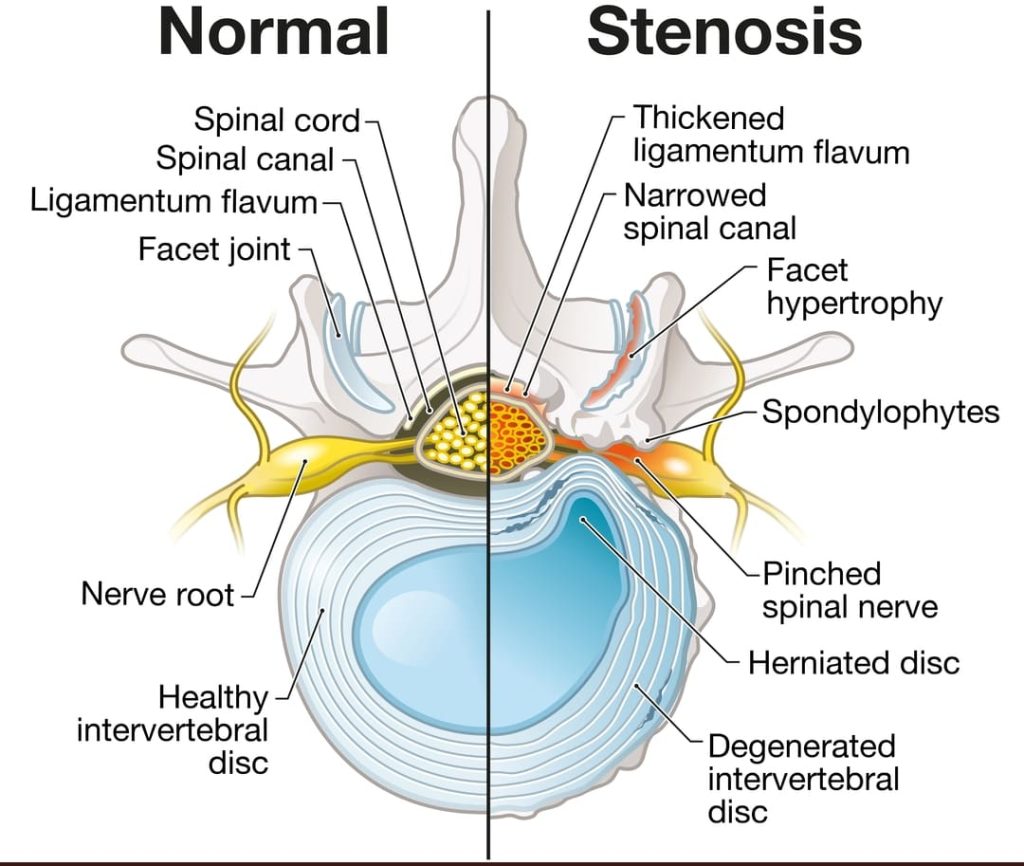Looking for Expert-Level VA Claim Answers?📱Call Us Now! 737-295-2226
Spinal stenosis is a painful, often disabling condition that affects many veterans, especially those who’ve endured years of physical strain during service. If you’ve been diagnosed with spinal stenosis, you may qualify for VA disability compensation.
In this ultimate veteran’s guide, we break down how the VA rates spinal stenosis, how to prove it’s service-connected, and what to do if your condition has worsened or developed secondary complications.
Table of Contents
Summary of Key Points
- Spinal stenosis occurs when spaces in the spine narrow, putting pressure on the spinal cord or nerves, leading to pain, numbness, or weakness.
- VA disability ratings for spinal stenosis range from 0% to 100%, based on severity, range of motion, and associated conditions like nerve damage or radiculopathy.
- Veterans can establish service connection directly, secondarily (e.g., from degenerative disc disease), or through aggravation of a preexisting condition.
What is Spinal Stenosis?

Spinal stenosis is a serious condition that occurs when the spaces within your spine narrow, putting pressure on the spinal cord or nearby nerves. This compression can cause significant pain, numbness, and mobility issues, making everyday tasks difficult or impossible.
For veterans, spinal stenosis can be especially debilitating, often limiting your ability to walk, stand, or lift—activities essential to daily life.
Common symptoms of spinal stenosis include:
- Chronic back or neck pain
- Cramping or pain in one or both legs
- Numbness, tingling, or weakness in the legs or feet
- Sciatica (radiating leg pain)
- Trouble walking or standing for extended periods
- Loss of coordination or balance
- Bladder or bowel problems, including incontinence or urgency
What causes spinal stenosis?
Spinal stenosis can be caused by many things, including degenerative changes in the spine, bone spurs, herniated discs, spinal tumors, or spinal injury. Stenosis often results from wear and tear on the spine with age. However, spinal stenosis can also occur in younger veterans and can be caused by service-related injuries.
Veterans who have sustained spinal injuries during service are at a higher risk for developing spinal stenosis later in life.

In addition, veterans who suffer from other conditions like osteoarthritis or degenerative disc disease are more likely to develop spinal stenosis. Regardless of the cause, spinal stenosis can be debilitating, causing pain, numbness, and weakness in the limbs.
Fortunately, several treatments are available to help ease the symptoms of spinal stenosis and improve your quality of life.
Proving Service Connection
To get VA disability for spinal stenosis, the VA must service-connect your condition. You’ll need to show that your spinal stenosis was caused by or aggravated by your time in service.
To be eligible for a spinal stenosis VA rating, you must meet three criteria by law:
- You have a medical diagnosis for spinal stenosis, and you’re experiencing current symptoms
- You experienced an event, injury, or illness while you were serving that caused or aggravated your spinal stenosis (either directly or indirectly)
- There’s a nexus (or a link) between your spinal stenosis and your military service
You can do this with medical records, lay evidence (testimony from friends or family members), or a nexus letter from a doctor linking your service-connected condition to an event or injury during your time in service.
There are several different ways to establish service connection for spinal stenosis:
- Direct Service Connection – This is when there is a clear link between your spinal stenosis and your military service. An example would be if you had a back injury or other trauma while serving that led to spinal stenosis.
- Secondary service connection – If another injury or illness caused by service connection eventually leads to your spinal stenosis. One example is if you’re already service-connected for a herniated disk.
The VA’s burden of proof for service connection is that your spinal stenosis is “at least as likely as not” caused or worsened by your military service. The strongest nexus letters include a nexus statement with the words “at least as likely as not,” assuming the independent medical provider believes your spinal stenosis was caused or worsened by your active duty military service.
You’ll also be required to provide the VA with medical imaging tests to show that you have spinal stenosis and its severity. This could be in the form of MRIs or CT scans taken by your private doctor or from military or VA medical records.
Spinal stenosis is usually very apparent in these images, and these images are compelling evidence.
Spinal Stenosis VA Ratings
VA ratings for spinal stenosis typically range from 10% to 100% and are based on limited range of motion, spinal fusion (ankylosis), and neurological symptoms like radiculopathy, bowel, or bladder issues, which may qualify for separate ratings.
The VA may assign separate ratings for spinal stenosis that affects both the lumbar (lower back) and cervical (neck)spine.
Most spinal stenosis claims are rated under Diagnostic Code 5238 using the General Rating Formula for Diseases and Injuries of the Spine. This formula bases your rating on the severity of movement restriction and functional loss in the affected spinal region.
In some cases—such as minimal evidence in your medical records—the VA may consider an alternate rating approach. But for most veterans, your range of motion (ROM) and the impact on daily activities will determine your final VA rating.
100% VA Rating
To be granted a VA disability rating for spinal stenosis at 100%, you must have unfavorable ankylosis of the entire spine and additional symptoms. Unfavorable ankylosis means that you cannot move your spine in any direction, and your spine is frozen in an unfavorable position.
To be considered for a 100% rating, you must have a “frozen” spine along with at least one of these symptoms:
- Vision impairment that makes it difficult to walk
- A restricted opening of the mouth can make it difficult to chew food.
- Breathing is limited to diaphragmatic respiration or abdominal breathing
- Gastrointestinal symptoms can be caused by pressure on the abdomen from the bottom edge of your rib cage
- Shortness of breath
- Difficulty swallowing
- Vertebrae slippage with a high likelihood of damage to the spinal cord
- Misalignment or dislocation of the 1st and 2nd vertebrae in your neck
- Other neurological symptoms caused by nerve root stretching
50% VA Rating
To be granted a VA disability rating for spinal stenosis at 50%, you must have virtually no range of motion, with your mid and upper back frozen in an unfavorable position. You have unfavorable ankylosis of the entire thoracolumbar spine. This portion of your spine is made up of 29 vertebrae and includes the vertebrae from your neck all the way down to your sacrum.
40% VA Rating
At this rating, the VA begins to assign cervical spinal stenosis VA disability ratings. In order to be granted a VA disability rating for spinal stenosis at 40%, you must meet one of these conditions:
- Unfavorable ankylosis of the entire cervical spine (your cervical spine goes from the base of your skull or your neck down to your shoulders and is made up of 7 vertebrae)
- Forward flexion of the thoracolumbar spine 30 degrees or less, or
- Favorable ankylosis of the entire thoracolumbar spine, where your spine is fixed in place, but at a neutral position at 0 degrees.
30% VA Rating
In order to be granted a VA disability rating for spinal stenosis at 30%, you must meet either of these conditions:
- Unfavorable ankylosis of the entire cervical spine, or
- Favorable ankylosis of the entire cervical spine, where your spine is fixed in place but at a neutral position at 0 degrees.
20% VA Rating
In order to be granted a VA disability rating for spinal stenosis at 20%, you must meet one of these conditions:
- The thoracolumbar spine (the part of the spine between your chest and your lower back) can bend more than 30 degrees but not more than 60 degrees
- The cervical spine (the part of your spine in your neck) can bend forward more than 15 degrees but not more than 30 degrees
- The combined range of motion of the thoracolumbar spine is not greater than 120 degrees
- The combined range of motion of the cervical spine is not greater than 170 degrees, or
- Muscle spasms or guarding cause an abnormal gait or spinal contour. This might mean that your spine is curved in a way that is not normal or that your back is very stiff and you have scoliosis, reversed lordosis, or abnormal kyphosis
10% VA Rating
In order to be granted a VA disability rating for spinal stenosis at 10%, you must meet one of these conditions:
- The thoracolumbar spine (the part of the spine between your chest and your lower back) can bend more than 60 degrees but not more than 85 degrees
- The cervical spine (the part of your spine in your neck) can bend forward more than 30 degrees but not more than 40 degrees
- The combined range of motion of the thoracolumbar spine is greater than 120 degrees but not greater than 235 degrees
- The combined range of motion of the cervical spine is greater than 170 degrees but not greater than 335 degrees, or
- Muscle spasm, guarding, or localized tenderness not resulting in abnormal gait or abnormal spinal contour; or vertebral body fracture with loss of 50 percent or more of the height
Alternative Method to Rate Spinal Stenosis
You may not be showing severe symptoms of spinal stenosis. Still, you may be experiencing a great deal of pain or spinal instability. In this case, the VA could rate you under Diagnostic Code 5243 if you’re experiencing intervertebral disc disease syndrome. You could be eligible for a higher VA rating under this diagnostic code, under the rating criteria for incapacitating episodes.
An incapacitating episode is when a veteran is prescribed bed rest by their doctor. The VA rates incapacitating episodes from 10% to 60%:
- 60% – You’ve experienced at least six weeks of incapacitating episodes in the past year.
- 40% – You’ve experienced at least four weeks of incapacitating episodes in the past year.
- 20% – You’ve experienced at least two weeks of incapacitating episodes in the past year.
- 10% – You’ve experienced at least one week of incapacitating episodes in the past year.
C&P Exam for Spinal Stenosis
You can expect a few things if you have a Compensation and Pension (C&P) exam for your spinal stenosis VA rating. During this exam, the physician will most likely ask you questions to determine how far you can move your spine and what portions of your spine you cannot move. The doctor will be considering which rating method to use during your evaluation.
VA disability ratings for spinal stenosis require an accurate range of motion test of the flexion of different sections of your spine. A goniometer should be used at your C&P exam to measure your spine’s range of motion; each measurement is rounded to the nearest five degrees.
Make sure you don’t push through the pain for these range of motion tests. If you feel any discomfort during the test, stop. Many veterans tend to downplay symptoms. You must be truthful with your evaluator during your C&P exam to get the rating you deserve.
Read the C&P Examiner’s Guide for spinal stenosis here.
Conclusion
Living with spinal stenosis can be overwhelming, but you don’t have to go through the VA claims process alone. With the right medical evidence and a clear service connection, many veterans are able to secure the monthly compensation they’ve earned.
If your spinal condition is limiting your movement, causing nerve pain, or impacting your daily life, it’s worth filing a claim or seeking a rating increase. And if you’ve already been denied, you may still have strong grounds for appeal.
FAQs | Frequently Asked Questions
What is spinal stenosis, and how does it affect veterans?
Spinal stenosis is the narrowing of spaces within the spine, which can put pressure on nerves and the spinal cord. It can result in chronic back or neck pain, numbness, weakness, and mobility issues, especially for veterans who experienced heavy lifting, impact, or injuries during service.
How does the VA rate spinal stenosis?
The VA rates spinal stenosis under the General Rating Formula for Diseases and Injuries of the Spine (38 CFR § 4.71a). Ratings range from 0% to 100%, based on loss of range of motion, spinal fusion, ankylosis, and neurological symptoms like radiculopathy.
Can spinal stenosis be rated as a secondary condition?
Yes. You may be able to claim spinal stenosis as secondary to conditions like degenerative disc disease, spinal arthritis, or past back injuries that were service-connected.
Can I get separate ratings for spinal stenosis and nerve issues like sciatica?
It’s possible. If your spinal stenosis causes radiculopathy (nerve pain radiating to the legs or arms), you may be eligible for separate ratings for each affected nerve group, in addition to your spinal stenosis rating.
What kind of evidence do I need for a spinal stenosis VA claim?
Strong claims often include MRIs or imaging, range of motion testing, and a medical Nexus letter linking your condition to service. Statements in support of claim can also strengthen your claim.
Want Expert-Level Support for Your VA Disability Claim? WE GOT YOUR SIX!
- VA Claims Insider is the #1 most trusted name in VA disability claims.
- Work directly with a VA claims coach who can educate you to VA claim victory.
- 25,000+ disabled veterans have served in our membership programs since 2016.
- 30% average rating increase for veterans who complete our #1-rated Elite program.
- 4.7/5.0 average rating out of 5,500+ total reviews; over 4,500 5-star reviews.
Author

Eric Webb
Eric has written and worked in the field of Veterans Disability since 2020 and enjoys writing educational content for the veteran population. His prior work has been published in the Official Journal of the American College of Sports Medicine (ACSM). He holds a Degree in Health and Exercise Science.



